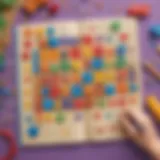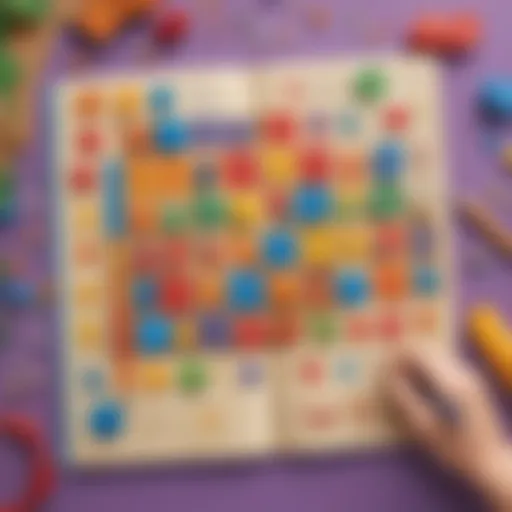Essential Knowledge Every Fifth Grader Needs


Intro
In the pivotal year of fifth grade, children stand at the crossroads of their early education. This is a time when the foundation is laid for future academic success and personal development. It's more than just multiplication tables or historical dates; it’s about building critical thinking skills, fostering creativity, and understanding societal interactions. In this journey, fifth graders will explore various subjects that not only prepare them for middle school but also for life beyond the classroom.
This article aims to provide a comprehensive guide on what essential knowledge fifth graders should acquire. It covers key points in mathematics, science, language arts, and social studies, while also touching on social and emotional learning, technology integration, and the importance of extracurricular activities. Through understanding these foundational elements, parents and caregivers can assist their children in navigating this critical phase of education.
Creative Activities
Fifth graders thrive when they engage in creative activities that encourage self-expression and reinforce learning. Such activities can take various forms—crafts, projects, or simple experiments that blend fun with education. Here are some enriching ideas:
Craft Ideas
- Nature Collage: Using leaves, flowers, and twigs, children can create a beautiful collage while learning about local flora.
- Story Stones: Painting different images on stones can help children narrate stories and develop creative writing skills.
Step-by-Step Guides
Creating these crafts doesn't have to be a daunting task. Here are some easy-to-follow steps:
- Nature Collage:
- Story Stones:
- Go for a nature walk and gather materials.
- Use a sturdy piece of cardboard as the base.
- Arrange the items in a visually appealing way.
- Glue everything down and display it proudly.
- Pick smooth stones and clean them.
- Use acrylic paint to draw images (animals, actions, emotions).
- Once dry, use the stones to create a story with friends or family members.
Educational Value
These activities aren’t merely pastimes. They enhance fine motor skills, stimulate creativity, and encourage collaboration. Moreover, they provide practical applications for the knowledge acquired in core subjects. Engaging in crafts keeps young minds active, blending fun with rich learning experiences.
Fun Quizzes
Quizzes can be a lively way for fifth graders to consolidate their knowledge while enjoying themselves. They can cover a multitude of topics, connecting learning with an element of challenge.
Quiz Topics
- Math Problems: Covering fractions, geometry, and basic algebra concepts.
- Science Facts: Exploring the solar system, ecosystems, and basic biology.
- History Questions: Engaging content related to significant historical events.
Question Types
To keep things exciting, quizzes should incorporate various question types. This can include:
- Multiple Choice questions, which allow for quick recall.
- True or False for binary thinking.
- Short Answer to encourage more profound thought and explanation.
Knowledge Reinforcement
Quizzes help reinforce learning by prompting students to recall information in a dynamic way, fostering retention and application of knowledge in practical contexts. They are not just about getting the right answer; they're about understanding concepts and encouraging curiosity.
Fact-Based Articles
To expand their understanding, fact-based articles are an excellent resource. They can cover a wide range of subjects, from science innovations to important historical figures.
Topics
- Current events that impact society and the environment.
- Profiles of influential artists and scientists.
- Basics of economics and geography.
Engaging Content
These articles present information through accessible language and eye-catching visuals, capturing the interests of fifth graders. They break down complex ideas into digestible chunks, ensuring understanding without overwhelming the reader.
Foreword to Fifth Grade Learning Expectations
Fifth grade marks a critical point in a child’s educational journey. As students transition from elementary school to the more rigorous demands of middle school, they face heightened academic expectations and social dynamics. It’s imperative for both children and their guardians to grasp what lies ahead. The learning expectations at this stage not only set the groundwork for future success but also help in shaping a child’s self-worth and confidence in their abilities.
Understanding these expectations provides context. With clear knowledge of what topics will be covered, students can approach the year armed with curiosity and enthusiasm. By recognizing the emotional and developmental aspects that come into play, parents can assist their kids in navigating both the academic landscape and the social minefields of fifth grade.
Overview of Fifth Grade Curriculum
Fifth grade encompasses a rich curriculum that dives into various subjects, equipping students with essential skills that go beyond the classroom. Here’s a breakdown:
- Mathematics: In this year, the focus is on number operations, fractions, decimals, and even basic geometry. Students will learn to solve multi-step problems, which sets the stage for more complex mathematical reasoning.
- Science: Whether it’s exploring Earth and Space Science or delving into the marvels of living organisms, this subject awakens curiosity about the world around them. Experiments often become a staple, allowing hands-on exploration.
- Language Arts: Reading comprehension takes on new levels as students tackle more challenging texts. Writing skills improve through structured essays and creative pieces, making language exploration both deep and multifaceted.
- Social Studies: Here, students get into the nitty-gritty of geography, different cultures, and basic economic principles, all essential for fostering informed global citizens.


This curriculum not only supports academic growth but also encourages critical thinking and collaboration. Engaging in discussions and group projects enhances social skills, reinforcing the idea that learning does not happen in isolation.
Developmental Milestones
At age ten or eleven, children reach several developmental milestones. These milestones play a vital role in shaping their learning experiences in fifth grade. Developmentally, they start experimenting with more independence and capability in their learning process.
- Cognitive Development: Fifth graders typically begin to think more abstractly. They start connecting ideas and concepts that may seem unrelated. For example, understanding fractions not just as numbers, but as parts of a whole in practical scenarios like cooking.
- Social Skills: During this year, students often form deeper friendships and understand diverse perspectives. They might begin to cooperate more effectively in group tasks, learning vital skills such as compromise and active listening.
- Emotional Growth: Emotional regulation becomes a centerpiece of their development. Fifth graders need guidance on navigating their feelings, especially when faced with challenges or changes.
"Fifth grade is like a bridge. It connects the carefree days of elementary school with the responsibilities of middle school."
Thus, understanding these milestones illuminates how crucial support from parents and educators is during this transformative year. With appropriate frameworks in place, children can thrive academically while also embracing their personal growth.
Core Academic Subjects
Core academic subjects form the backbone of fifth-grade education. They are essential not just for passing tests, but for understanding the world and developing critical thinking skills. Here, we dive into each major area: mathematics, science, language arts, and social studies. Knowing these subjects prepares students for middle school and beyond, equipping them with knowledge that molds their perspectives and helps them navigate life.
Mathematics Proficiency
Number Operations and Algebra
Number operations and algebra lay the groundwork for more advanced mathematics. In fifth grade, students learn to tackle basic operations with whole numbers, decimals, and integers. A key characteristic here is the introduction of variables and simple equations, giving kids the tools to solve real-world problems. It helps develop logical thinking, which is crucial as they progress to higher-level math.
An interesting feature of number operations is how they relate to everyday situations—like budgeting allowance or sharing snacks among friends. The advantages include a stronger grasp of problem-solving skills; however, some children might find abstract concepts challenging.
Fractions and Decimals
Fractions and decimals are like two sides of the same coin. Understanding them is crucial for tasks like cooking or shopping. Fifth graders start to perform operations with fractions—adding, subtracting, multiplying, and dividing. A significant attribute here is the relationship between fractions and decimals, providing a bridge for students to understand numbers in different forms.
One unique aspect is their application in real life, like measuring ingredients while cooking or calculating discounts during sales. The downside might be that these concepts can confuse students who struggle with the "part of a whole" mindset.
Geometry Concepts
Geometry adds a spatial element to math skills. Fifth-grade geometry includes understanding shapes, area, perimeter, and volume. A valuable part of this is how it applies to the world around us, such as calculating the area of a garden or the volume of a box. Geometry encourages creativity, as students often use drawings and models to express their understanding.
This segment's unique feature is its visualization aspect, allowing students to see and interact with shapes, which is a distinct advantage. But, like with other math concepts, some might grapple with terms or principles—especially if they haven't had much exposure before.
Science Fundamentals
Earth and Space Science
Earth and space science opens the door to understanding the environment and universe. Fifth graders explore topics related to weather, rock cycles, and the solar system. It's critical as it encourages curiosity about our planet and the cosmos. One appeals is learning why things happen, like why winter is colder than summer based on Earth's tilt.
A unique feature of this area is hands-on learning through experiments and observation, which makes the knowledge gleaned both practical and tangible. On the downside, the sheer vastness of topics can overwhelm some students, making it hard to grasp everything.
Life Science
Life science focuses on living organisms—from plants to animals and ecosystems. Understanding the relationships in nature teaches children about biological systems. This subject is rich because it connects students to the natural world they live in, fostering respect and appreciation for organisms and their environments.
The unique feature here is the inquiry aspect; students often engage firsthand with ecosystems, fostering a sense of exploration. However, some may find it challenging to remember specific terms and the classification of various life forms.
Physical Science
Physical science discusses matter and energy, introducing principles of physics and chemistry. In fifth grade, kids learn about forces, motion, and basic chemical reactions. This field is vital because it explains many phenomena kids encounter every day, like why a ball bounces or what happens when you mix certain elements.
One distinctive characteristic is the experimental aspect, where students can see concepts in action through labs and demonstrations. Nonetheless, the downside may be when students encounter abstract concepts that are hard for them to visualize, like atoms or forces.
Language Arts Skills
Reading Comprehension Techniques
Reading comprehension is about more than just recognizing words. Fifth graders delve into understanding the underlying messages, themes, and purposes of texts. A key characteristic is developing analytical thinking, allowing students to ask questions and draw conclusions about what they read.
The unique element is the variety of texts—stories, nonfiction, poems—that engage different interests, fostering a lifelong love of reading. The challenge, however, can be deciphering complex texts that require critical skills beyond basic comprehension.
Writing and Composition Skills
Writing and composition skills encourage students to express their thoughts clearly and effectively. In this grade, children learn to structure paragraphs, articulate arguments, and use proper grammar. A strong point here is improving communication skills that benefit both academics and everyday life.
What sets writing apart is the creativity involved, as children use their voice to convey ideas. Still, some may struggle with writer's block or lack confidence, especially when receiving feedback on their work.
Vocabulary Development


Vocabulary development is fundamental in broadening language skills. Fifth graders focus on acquiring new words and understanding their meanings in context, which enhances both reading and writing abilities. A primary characteristic is the importance of context, as words can change meanings based on how they are used.
The unique feature lies in how vocabulary empowers students to articulate their thoughts better. However, the downside can be an overwhelming amount of new words, which may deter some students from engaging with text.
Social Studies Knowledge
Geography Basics
Understanding geography involves more than just maps; it's about comprehending places, environments, and cultures. Fifth graders learn about continents, oceans, and various geographical features. This knowledge is critical as it helps students make sense of the world’s layout and global events.
A key characteristic is its relevance to current events—knowing geography aids in understanding news articles and discussions. The challenge may come with the sheer volume of information, sometimes making it difficult to retain knowledge about different regions and their features.
History and Culture
History and culture cover the stories and influences that shape societies. Fifth graders explore significant events, movements, and figures who impacted the world. A vital aspect here is fostering an appreciation for diversity and historical contexts.
What makes this subject unique is its narrative aspect, as students learn about different perspectives and experiences. However, absorbing all the details can be a tough nut to crack for some, leading to gaps in understanding significant historical context.
Economics and Government
Economics and government education is vital for understanding systems that run societies. Fifth graders tackle basic concepts of supply and demand, economy types, and governance structures. A key characteristic is encouraging civic awareness and responsibility, fostering informed future citizens.
The unique feature here is the practical implications; students relate these concepts to their own lives, like marketplace experiences or community participation. On the flip side, these topics can be quite abstract and sometimes challenging to grasp, especially for younger students.
In summary, the core academic subjects for fifth graders are not just about memorization but understanding concepts that will assist them throughout their educational journey. These subjects build a strong foundation to navigate the complexities of the world around them.
Social and Emotional Learning
Social and Emotional Learning (SEL) has gained a lot of traction in recent years, and for good reason. It’s not just about academics; it molds well-rounded individuals. Teaching children these skills helps them navigate life beyond the classroom. Understanding and enhancing social and emotional capabilities prepares fifth graders for the complex world ahead.
Benefits of Social and Emotional Learning:
- Improved Relationships: Children learn how to communicate, cooperate, and resolve conflicts, skills that lay the groundwork for lasting relationships.
- Enhanced Self-Awareness: Awareness of one’s emotions greatly helps in understanding oneself. This can lead to better decision-making and personal growth.
- Boosted Academic Performance: Studies show that when children feel safe and supported emotionally, their engagement and interest in academic subjects increase, leading to better overall performance.
"When children learn to manage their emotions and build good relationships, they set the stage for lifelong happiness and success."
Fifth grade is often a pivotal point where children begin to experience a mix of social dynamics that can affect their emotional well-being. Encouraging them to cultivate empathy, compassion, and understanding helps them build a supportive network among peers.
Developing Healthy Relationships
Fifth graders are right at that stage in life where friendships start to mean everything, and this makes it crucial for them to develop healthy relationships. Teaching them how to recognize positive versus toxic relationships sets the stage for future interactions. Kids this age are likely to spend considerable time with friends, which means positive relationships can uplift their spirits while negative ones could drain them.
Key Points for Healthy Relationships:
- Communication: Encouraging open dialogue is key. Encourage them to express their feelings honestly and listen actively to their friends.
- Boundaries: Helping them understand personal boundaries is essential. Teach them that it's okay to say no, and that respecting others' boundaries is part of a good friendship.
- Trust: Building trust takes time. Children need to learn that trust requires honesty and reliability.
Emotional Regulation Strategies
Regulating emotions is a skill that doesn't come naturally to most kids. However, it's an indispensable part of SEL. Fifth graders may experience a range of emotions that can influence their behavior and interactions. Teaching them how to identify and manage these emotions will empower them in both academic and personal settings.
Strategies for Emotional Regulation:
- Mindfulness Practices: Simple breathing exercises or quiet moments can help students center themselves when feeling overwhelmed.
- Journaling: Writing down thoughts may assist kids in processing their emotions. A private journal allows them to express feelings without fear of judgment.
- Recognizing Triggers: Helping children identify what situations or interactions provoke strong emotions can lead to proactive strategies to handle them better.
- Seeking Help: It's important for children to understand that reaching out for help when overwhelmed is not a sign of weakness.
By instilling these practices, children can mature into emotionally intelligent adults. They will navigate life's challenges with grace and confidence, leading to healthier interactions and decision-making in the years to come.
Technology and Digital Literacy
In today's world, technology is not just a luxury but a necessity. For fifth graders, grasping the ropes of technology and digital literacy sets the stage for their future. Technology influences every facet of life from education to communications. The skills they develop today will support not just their current academic pursuits, but also equip them for their years ahead. Learning technology is similar to riding a bike; once you get the hang of it, you realize that you can go places you never thought possible.
Technology and digital literacy encapsulates a broad set of skills. From using basic computer functions to understanding safe internet practices, these foundational skills are vital. They empower students to harness information, create innovative work, and interact effectively with others in both virtual and physical spaces. Thus, a sound understanding of these topics proves immensely beneficial for children as they navigate the ups and downs of an increasingly tech-driven society.
Basic Computer Skills
Basic computer skills are the building blocks of digital literacy. It’s essential for fifth graders to be comfortable with various functions of a computer. This includes:
- Understanding Operating Systems: Knowing the basics of how a computer runs; Windows, macOS, or even Chrome OS.
- Familiarity with Software: Learning to use word processors like Microsoft Word, spreadsheets such as Excel, and presentation tools like PowerPoint can set the groundwork for future academic projects.
- File Management: Grasping how to create, save, and organize files is crucial. Not knowing how to find important documents can turn into a stressful situation quickly.
- Basic Troubleshooting: Simple issues like not being able to connect to Wi-Fi or dealing with a frozen screen can happen to anyone. Knowing what to try in these moments is a handy skill.
Becoming adept in these areas builds confidence. Students who can navigate their computers effectively feel more at ease in utilizing technology for their studies and other pursuits.


Safe Internet Practices
Using the internet is something that many students do regularly. However, understanding how to do so safely is paramount. Safe internet practices can help protect children from various online risks and ensure their digital footprint remains secure. Here are some core principles:
- Keeping Personal Information Private: It's important for fifth graders to know not to share details like their home address, phone number, or school name with strangers online. Simple reminders such as "Strangers are like ghosts—don’t let them know your secrets" can help enforce this.
- Recognizing Trustworthy Sources: Students should learn the difference between credible websites and those that might spread misinformation. Understanding how to evaluate information encourages critical thinking.
- Understanding Cyberbullying: Introducing children to the concept of online harassment and its effects fosters empathy. They should know to speak up either for themselves or others when they notice bad behavior online.
- Using Privacy Settings: Familiarity with privacy settings on social media and other online platforms is key to controlling who can see their information.
"With great power comes great responsibility." This old saying rings true in the digital age. Teaching students safe internet practices isn't just about safeguarding them; it's also about helping them navigate their digital world with awareness and respect.
Extracurricular Activities
Extracurricular activities play a pivotal role in the development of fifth graders, weaving an enriched tapestry of skills that extend far beyond the standard classroom curriculum. These activities not only foster academic readiness but also support social and emotional growth, which is equally crucial during this stage of education. Engaging in a variety of extracurricular offerings, such as sports, arts, and service projects, can enhance self-esteem and interpersonal skills. These engagements provide students with the opportunity to explore their interests, hone their talents, and make lasting memories.
Sports and Physical Education
Participating in sports and physical education is more than just running around or playing a game; it molds physical health and promotes teamwork, discipline, and goal-setting. Fifth graders are at a stage where they gain a deeper understanding of collaboration and competition.
- Teamwork: Learning to work as a unit teaches kids valuable lessons in cooperation. Whether they are passing a soccer ball or coordinating a relay, these exercises instill a sense of camaraderie.
- Health Consequences: Regular physical activity helps combat obesity and encourages healthy habits. Kids also learn the importance of fitness, which can stay with them for life.
- Goal Achievement: Setting and reaching personal or team goals fosters resilience and self-efficacy, showing students that with effort, they can improve and succeed.
Involvement in sports can create a sense of belonging, a feeling that every child desires; it’s a gateway to making friendships that may last well beyond school days.
Arts and Crafts Involvement
The realm of arts and crafts offers a unique avenue for self-expression and creativity. Fifth graders often experience a surge in imaginative thinking, and arts allow them to channel those thoughts into something tangible.
- Creative Expression: Art can speak volumes. Children use colors, shapes, and textures to convey their feelings and stories that words sometimes fail to express.
- Fine Motor Skills: Crafting improves hand-eye coordination and dexterity, skills that are essential as children engage further in educational activities across disciplines.
- Cultural Awareness: Art incorporates elements from diverse cultures, allowing students to appreciate and respect differences, nurturing empathy and understanding.
Each brushstroke and glue stick contributes not just to their artworks but also to their psychological growth, enabling greater confidence in sharing their visions and thoughts.
Community Service Engagement
Getting involved in community service instills a sense of responsibility and compassion. Fifth graders are at an age where empathy becomes a focal point in their development, and participating in community initiatives allows them to actively contribute to their surroundings.
- Civic Responsibility: Understanding the importance of giving back nurtures a lifelong sense of civic duty. Kids learn that their actions can make a difference, no matter how small.
- Broadened Perspectives: Engaging with different community groups helps children see the world from varied viewpoints—something that can shape their worldview.
- Collaboration and Leadership: Working on service projects encourages leadership skills and collaboration. They learn to plan, execute tasks, and work effectively in groups.
In summary, extracurricular activities envelop the fundamental aspects of a child's development that classroom learning alone cannot provide. They blend educational benefits with social interaction, forming a crucial foundation of not just academic success but also of personal growth.
Preparing for Middle School
As fifth graders approach the end of their elementary school journey, the transition to middle school looms closer, bringing with it a host of changes and challenges. Understanding the ins and outs of this pivotal phase in education is paramount for students, parents, and caregivers alike. The importance of preparing for middle school cannot be overstated. It’s not merely about adjusting to a new school environment; it’s also about developing the skills and mindset that will pave the way for future success.
Middle school represents a significant shift in academic expectations and social dynamics. Students are expected to take on more responsibility, both personally and academically. They encounter different teachers for each subject and become adept at managing their time effectively. This stage is foundational as it sets the tone for their high school experience and beyond, making preparation crucial. Here are some key elements, considerations, and benefits of gearing up for this transition:
- Academic Independence: Middle school encourages students to take charge of their learning, requiring them to stay organized and manage multiple subjects simultaneously.
- New Social Landscape: Students meet peers from various backgrounds, expanding their social skills and fostering new friendships. Navigating these dynamics can be both exhilarating and daunting.
- Extra-Curricular Options: With more activities and clubs available, students can explore interests that might shape their future paths.
"Transition to middle school is like stepping into a whole new world, one where every lesson learned is a stepping stone toward adulthood."
Transition Strategies
One of the most significant aspects of preparing for middle school involves devising effective transition strategies. Students need to move from the familiar comforts of elementary school to a new environment that may feel overwhelming at first. Here, we explore practical strategies to ease this transition:
- Visit the School: If possible, arrange a visit to the new middle school before the academic year starts. Familiarity with the layout and facilities can reduce anxiety.
- Connect with Upcoming Peers: Encourage the child to reach out to friends who will also be attending the same middle school. Knowing someone on the first day can be a great comfort.
- Stay Organized: Help students establish a daily planner for their assignments, school events, and extra-curricular activities. Good time management skills will be beneficial from the get-go.
Setting Academic Goals
Setting clear academic goals is another essential component of preparing for middle school. As responsibilities increase, having specific goals can help students maintain focus and motivation. These goals don’t have to be monumental; even small, achievable targets can foster a sense of accomplishment. Here are a few ways to set effective academic goals:
- Short-Term Goals: These can include targets for a single semester, like maintaining a specific grade in math or completing all reading assignments on time.
- Long-Term Goals: Think more broadly, such as aiming to be accepted into a particular high school, or developing a strong foundation in a favorite subject that could translate into a future career.
- Reflection and Adaptation: Regularly review the goals set. Students should understand that it’s alright to adjust them based on their progress and personal circumstances. This is part of the learning process.
By being proactive—understanding the magnitude of the transition, applying strategies to navigate it, and establishing clear academic goals—students can enter middle school with confidence and preparedness. This careful planning ensures they not only survive but thrive in the next stage of their education.
Finale: A Holistic Approach to Learning in Fifth Grade
Interconnected Learning
While academics are of utmost importance, fifth grade spans far beyond mere subjects like math and science. The integration of social and emotional learning into the curriculum reinforces that students are not just data processors, but human beings with thoughts and feelings. Learning how to form healthy relationships, manage emotions, and cooperate with peers serves them well, not just in the classroom but throughout their lives.
- Academics: Focus on core subjects wrangling the complexities of mathematics, the mysteries of science, and the nuances of language arts.
- Social Skills: Developing emotional intelligence in a supportive environment.
- Technology: Fostering digital literacy through practical engagements with computers and safe internet use.
- Extracurricular Activities: Encouraging participation in sports, arts, and community service, creating balance between work and leisure.
Building Strong Foundations
Fifth grade serves as a bedrock for middle school learning and beyond. This is where students not only consolidate their existing skills but also develop critical new ones. Academic goals set during this time help instill a sense of responsibility for their own learning—a vital trait as they move forward. Teachers, parents, and the community must collaborate to ensure that children are equipped with the resources and support they need to thrive.
"It is not what we have learned but how we have learned that matters in the long run."
Preparing for the Future
The skills acquired in fifth grade are crucial for academic success and personal growth. By fostering a well-rounded educational experience that nurtures emotional health and fosters social skills along with strong academic foundations, we prepare fifth graders for a seamless transition into middle school and beyond. This comprehensive approach teaches them to adapt, innovate, and thrive in diverse environments.







